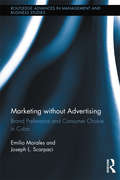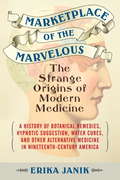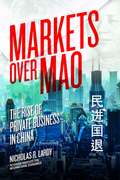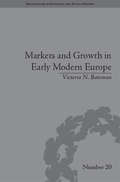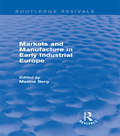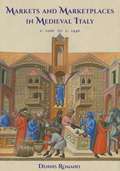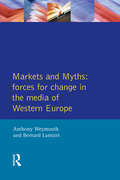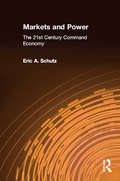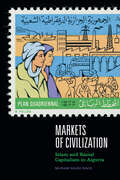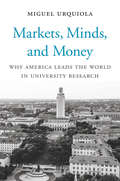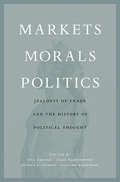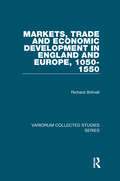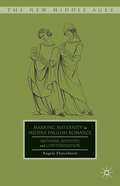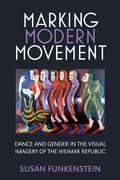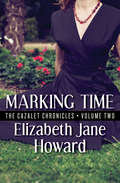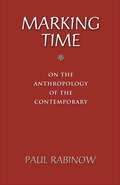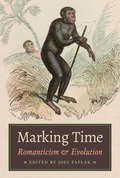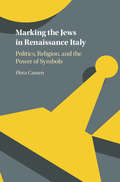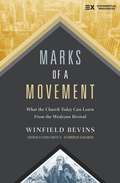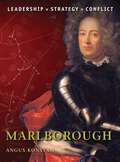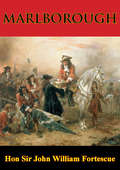- Table View
- List View
Marketing the Wilderness: Outdoor Recreation, Indigenous Activism, and the Battle over Public Lands
by Joseph WhitsonHow outdoor industry marketing promotes an image of &“the wilderness&” as an unpeopled havenMarketing the Wilderness analyzes the relationship between the outdoor recreation industry, public lands in the United States, and Indigenous sovereignty and representation in recreational spaces. Combining social media analysis, digital ethnography, and historical research, Joseph Whitson offers nuanced insights into more than a century of the outdoor recreation industry&’s marketing strategies, unraveling its complicity in settler colonialism. Complicating the narrative of outdoor recreation as a universal good, Whitson introduces the concept of &“wildernessing&” to describe the physical, legal, and rhetorical production of pristine, empty lands that undergirds the outdoor recreation industry, a process that further disenfranchises Indigenous people from whom these lands were stolen. He demonstrates how companies such as Patagonia and REI align with the mining and drilling industries in their need to remove Indigenous peoples and histories from valuable lands. And he describes the ways Indigenous and decolonial activists are subverting and resisting corporate marketing strategies to introduce new narratives of place. Through the lens of environmental justice activism, Marketing the Wilderness reconsiders the ethics of recreational land use, advocating for engagement with issues of cultural representation and appropriation informed by Indigenous perspectives. As he discusses contemporary public land advocacy around places such as Bears Ears National Monument, Whitson focuses on the deeply fraught relationship between the outdoor recreation industry and Indigenous communities. Emphasizing the power of the corporate system and its treatment of land as a commodity under capitalism, he shows how these tensions shape the American idea of &“wilderness&” and what it means to fight for its preservation. Retail e-book files for this title are screen-reader friendly with images accompanied by short alt text and/or extended descriptions.
Marketing without Advertising: Brand Preference and Consumer Choice in Cuba (Routledge Advances in Management and Business Studies)
by Emilio Morales Joseph L. ScarpaciIn 1993, in order to stop an economic freefall on the island of Cuba, Fidel Castro’s government reluctantly instituted a series of reforms to compensate for the demise of foreign aid from Moscow. These policies ushered in a broad spectrum of national and international consumer products and services previously unknown to islanders. In a few short years, Cubans were seeing foreign brands among consumer durables and a broad array of logos brought in by tourists. Today, nearly two decades into these limited market reforms, no systematic research has explored consumer brand awareness among 11 millions Cubans living just 90 miles from the United States. The paucity of academic research stems from the challenges of conducting public/consumer opinion, and official state policy contends that consumer wants and needs are satisfied by either a series of generic and Cuban-made brands, or by independent entrepreneurs who provide brandless products and services. Marketing without Advertising analyzes the role, narratives, and behaviour of consumption in Cuba since 1959. It documents how consumer behaviour has changed since the pre-revolutionary period, with special focus on the early 1990s. The book documents the shift from moral-based rewards in the early years of the Revolution, to the rise of material-based incentives. Cubans have long been exposed to foreign mass media in the form of movies, music videos, cable television shows. Although the Internet is highly regulated, the Cuban Diaspora in exile brings back clothing, personal care products, electronic goods, and magazines that increase the awareness of brand logos, jingles, products, and services. These and related findings from the authors' primary research are ripe with marketing implications such as substitution effects, price elasticity, latent demand for certain products and services, and consumer behaviour.
Marketplace of the Marvelous
by Erika JanikAn entertaining introduction to the quacks, snake-oil salesmen, and charlatans, who often had a point Despite rampant scientific innovation in nineteenth-century America, traditional medicine still adhered to ancient healing methods such as induced vomiting and bleeding, blistering, and sweating patients. Facing such horrors, many patients ran with open arms to burgeoning practices promising new ways to cure their ills: Hydropaths promised cures using "healing tubs." Franz Anton Mesmer applied magnets to a patient's body, while Daniel David Palmer restored a man's hearing by knocking on his vertebrae. Phrenologists emerged, claiming the topography of one's skull could reveal the intricacies of one's character. Bizarre as these methods may seem, many are the predecessors of today's notions of health. We have the nineteenth-century practice of "medical gymnastics" to thank for today's emphasis on daily exercise, and hydropathy's various water cures gave us the notion of showers and the mantra of "eight glasses of water a day." These early medical "deviants," including women who had been barred from the patriarchy of "legitimate doctoring," raised questions and posed challenges to established ideas, and though the fads faded and many were discredited by the scientific revolution, some ideas behind the quackery are staples in today's health industry. Janik tells the colorful stories of these "quacks," whose shams, foils, or genuine wish to heal helped shape and influence modern medicine.
Markets And Civil Society
by Victor Pa©rez-DaazThe nature of the currently emerging European society, which includes the economic and social transformation of Eastern and Central European countries, has been hotly debated. At its center is the relationship between markets and civil society within political and social contexts. The contributors to this volume offer perspectives from various disciplines (the social sciences, conceptual history, law, economics) and from several European countries in order to explore the ways in which markets influence various forms of civil society, such as individual freedom, social cohesion, economic effectiveness and democratic governance, and influence the construction of a civil society in a broader sense.
Markets And Civil Society
by Victor Pérez-DíazThe nature of the currently emerging European society, which includes the economic and social transformation of Eastern and Central European countries, has been hotly debated. At its center is the relationship between markets and civil society within political and social contexts. The contributors to this volume offer perspectives from various disciplines (the social sciences, conceptual history, law, economics) and from several European countries in order to explore the ways in which markets influence various forms of civil society, such as individual freedom, social cohesion, economic effectiveness and democratic governance, and influence the construction of a civil society in a broader sense.
Markets Over Mao: The Rise of Private Business in China
by Nicholas LardyChina's transition to a market economy has propelled its remarkable economic growth since the late 1970s. In this book, Nicholas R. Lardy, one of the world's foremost experts on the Chinese economy, traces the increasing role of market forces and refutes the widely advanced argument that Chinese economic progress rests on the government's control of the economy's "commanding heights." In another challenge to conventional wisdom, Lardy finds little evidence that the decade of the leadership of former President Hu Jintao and Premier Wen Jiabao (2003–13) dramatically increased the role and importance of state-owned firms, as many people argue. This book offers powerfully persuasive evidence that the major sources of China's growth in the future will be similarly market rather than state-driven, with private firms providing the major source of economic growth, the sole source of job creation, and the major contributor to China's still growing role as a global trader. Lardy does, however, call on China to deregulate and increase competition in those portions of the economy where state firms remain protected, especially in energy and finance.
Markets and Growth in Early Modern Europe (Perspectives in Economic and Social History #20)
by Victoria N BatemanThis is the first study to analyze a wide spread of price data to determine whether market development led to economic growth in the early modern period.
Markets and Manufacture in Early Industrial Europe (Routledge Revivals Ser.)
by Maxine BergThis edited collection, first published in 1991, focuses on the commercial relations, marketing structures and development of consumption that accompanied early industrial expansion. The papers examine aspects of industrial structure and work organisation, including women’s work, and highlight the conflict and compromise between work traditions and the emergence of a market culture. With an overarching introduction providing a background to European manufacturing, this title will be of particular interest to students of social and economic history researching early industrial Europe and the concurrent emergence of a material, consumer culture.
Markets and Market Places in Medieval Italy c. 1100 to c. 1440
by Dennis RomanoCathedrals and civic palaces stand to this day as symbols of the dynamism and creativity of the city-states that flourished in Italy during the Middle Ages. Markets and Marketplaces in Medieval Italy argues that the bustling yet impermanent sites of markets played an equally significant role, not only in the economic life of the Italian communes, but in their political, social, and cultural life as well. Drawing on a range of evidence from cities and towns across northern and central Italy, Dennis Romano explores the significance of the marketplace as the symbolic embodiment of the common good; its regulation and organization; the ethics of economic exchange; and how governments and guilds sought to promote market values. With a special focus on the spatial, architectural, and artistic elements of the marketplace, Romano adds new dimensions to our understanding of the evolution of the market economy and the origins of commercial capitalism and Renaissance individualism.
Markets and Myths: Forces For Change In the European Media
by Anthony Weymouth Bernard LamizetMarket and Myths: Forces for Change in the European Media is the first introductory text to provide a detailed analysis of the European Media in five major Western European countries within the context of a theoretical framework. All forms of the mass media are covered and the impact of media policy on the political, social and cultural life of the countries concerned - Britain, France, Germany, Italy and Spain. Issues such as the continuing role of public service broadcasting and the extent to which a process of Europeanisation has occurred within the Media are examined in a clear accessible style which will make this book essential reading for all those with an interest in the European Media.
Markets and Power: The 21st Century Command Economy
by Eric A. SchutzIn what ways do the actions and economic behavior of today's multinational corporations resemble the functioning and processes of the old command economics of the Soviet Union? By ignoring questions about power relations in markets, mainstream neoclassically-oriented economists conclude that there are no significant power structures operating in market systems to control allocation and distribution. This book argues to the contrary that there are fundamental and systemic power structures - monopoly, access to information or finance, employer power, etc. - at work in market economies, which affects their ability to achieve real "competition" in much the same way as state-controlled, command economies hinder business activities. Thus, for example, the biggest firms at the hubs of financial "networks" wield a kind of "shaping power" upon large numbers of relatively autonomous firms, not only upon those that belong to the networks but also on the many firms outside them that are also affected.
Markets of Civilization: Islam and Racial Capitalism in Algeria (Theory in Forms)
by Muriam Haleh DavisIn Markets of Civilization Muriam Haleh Davis provides a history of racial capitalism, showing how Islam became a racial category that shaped economic development in colonial and postcolonial Algeria. French officials in Paris and Algiers introduced what Davis terms “a racial regime of religion” that subjected Algerian Muslims to discriminatory political and economic structures. These experts believed that introducing a market economy would modernize society and discourage anticolonial nationalism. Planners, politicians, and economists implemented reforms that both sought to transform Algerians into modern economic subjects and drew on racial assumptions despite the formally color-blind policies of the French state. Following independence, convictions about the inherent link between religious beliefs and economic behavior continued to influence development policies. Algerian president Ahmed Ben Bella embraced a specifically Algerian socialism founded on Islamic principles, while French technocrats saw Algeria as a testing ground for development projects elsewhere in the Global South. Highlighting the entanglements of race and religion, Davis demonstrates that economic orthodoxies helped fashion understandings of national identity on both sides of the Mediterranean during decolonization.
Markets, Minds, and Money: Why America Leads the World in University Research
by Miguel UrquiolaA colorful history of US research universities, and a market-based theory of their global success. American education has its share of problems, but it excels in at least one area: university-based research. That’s why American universities have produced more Nobel Prize winners than those of the next twenty-nine countries combined. Economist Miguel Urquiola argues that the principal source of this triumph is a free-market approach to higher education. Until the late nineteenth century, research at American universities was largely an afterthought, suffering for the same reason that it now prospers: the free market permits institutional self-rule. Most universities exploited that flexibility to provide what well-heeled families and church benefactors wanted. They taught denominationally appropriate materials and produced the next generation of regional elites, no matter the students’—or their instructors’—competence. These schools were nothing like the German universities that led the world in research and advanced training. The American system only began to shift when certain universities, free to change their business model, realized there was demand in the industrial economy for students who were taught by experts and sorted by talent rather than breeding. Cornell and Johns Hopkins led the way, followed by Harvard, Columbia, and a few dozen others that remain centers of research. By the 1920s the United States was well on its way to producing the best university research. Free markets are not the solution for all educational problems. Urquiola explains why they are less successful at the primary and secondary level, areas in which the United States often lags. But the entrepreneurial spirit has certainly been the key to American leadership in the research sector that is so crucial to economic success.
Markets, Morals, Politics: Jealousy of Trade and the History of Political Thought
by Béla KapossyWhen István Hont died in 2013, the world lost a giant of intellectual history. A leader of the Cambridge School of Political Thought, Hont argued passionately for a global-historical approach to political ideas. To better understand the development of liberalism, he looked not only to the works of great thinkers but also to their reception and use amid revolution and interstate competition. His innovative program of study culminated in the landmark 2005 book Jealousy of Trade, which explores the birth of economic nationalism and other social effects of expanding eighteenth-century markets. Markets, Morals, Politics brings together a celebrated cast of Hont’s contemporaries to assess his influence, ideas, and methods. Richard Tuck, John Pocock, John Dunn, Raymond Geuss, Gareth Stedman Jones, Michael Sonenscher, John Robertson, Keith Tribe, Pasquale Pasquino, and Peter N. Miller contribute original essays on themes Hont treated with penetrating insight: the politics of commerce, debt, and luxury; the morality of markets; and economic limits on state power. The authors delve into questions about the relationship between states and markets, politics and economics, through examinations of key Enlightenment and pre-Enlightenment figures in context—Hobbes, Rousseau, Spinoza, and many others. The contributors also add depth to Hont’s lifelong, if sometimes veiled, engagement with Marx. The result is a work of interpretation that does justice to Hont’s influence while developing its own provocative and illuminating arguments. Markets, Morals, Politics will be a valuable companion to readers of Hont and anyone concerned with political economy and the history of ideas.
Markets, Trade and Economic Development in England and Europe, 1050-1550 (Variorum Collected Studies #918)
by Richard BritnellEngland's economy between 1050 and 1550 mirrored that of much of continental Europe in its growing dependence upon trade over both short distances and long. The essays in this collection are the fruit of forty years of research into the complex and interrelated issues involved. Describing this change can be achieved in part through quantitative indices, such as the number and size of towns, markets and fairs, and the volume of monetary circulation. A full account also requires a discussion of widespread changes of work experience, customary practices and moral values as households became more dependent upon markets. In addition, the evidence of transformative commercial growth in the medieval period gives rise to numerous questions concerning its relationship to more modern times. Modern economic growth and modern capitalism have often been contrasted starkly with medieval economic stagnation and traditionalism, but recent research implies a more continuous process of economic development than that implied by these older stereotypes. Many of the items in this collection are also relevant to this more discursive aspect of medieval commercialisation.
Marking Evil: Holocaust Memory in the Global Age (Making Sense of History #21)
by Amos Goldberg Haim HazanTalking about the Holocaust has provided an international language for ethics, victimization, political claims, and constructions of collective identity. As part of a worldwide vocabulary, that language helps set the tenor of the era of globalization. This volume addresses manifestations of Holocaust-engendered global discourse by critically examining their function and inherent dilemmas, and the ways in which Holocaust-related matters still instigate public debate and academic deliberation. It contends that the contradiction between the totalizing logic of globalization and the assumed uniqueness of the Holocaust generates continued intellectual and practical discontent.
Marking Maternity In Middle English Romance
by Angela FlorschuetzWorking at the intersection of medical, theological, cultural, and literary studies, this book offers an innovative approach to understanding maternity, genealogy and social identity as they are represented in popular literature in late-medieval England.
Marking Modern Movement: Dance and Gender in the Visual Imagery of the Weimar Republic (Social History, Popular Culture, And Politics In Germany)
by Susan FunkensteinImagine yourself in Weimar Germany: you are visually inundated with depictions of dance. Perusing a women’s magazine, you find photograph after photograph of leggy revue starlets, clad in sequins and feathers, coquettishly smiling at you. When you attend an art exhibition, you encounter Otto Dix’s six-foot-tall triptych Metropolis, featuring Charleston dancers in the latest luxurious fashions, or Emil Nolde’s watercolors of Mary Wigman, with their luminous blues and purples evoking her choreographies’ mystery and expressivity. Invited to the Bauhaus, you participate in the Metallic Festival, and witness the school’s transformation into a humorous, shiny, technological total work of art; you costume yourself by strapping a metal plate to your head, admire your reflection in the tin balls hanging from the ceiling, and dance the Bauhaus’ signature step in which you vigorously hop and stomp late into the night. Yet behind the razzle dazzle of these depictions and experiences was one far more complex involving issues of gender and the body during a tumultuous period in history, Germany’s first democracy (1918-1933). Rather than mere titillation, the images copiously illustrated and analyzed in Marking Modern Movement illuminate how visual artists and dancers befriended one another and collaborated together. In many ways because of these bonds, artists and dancers forged a new path in which images revealed artists’ deep understanding of dance, their dynamic engagement with popular culture, and out of that, a possibility of representing women dancers as cultural authorities to be respected. Through six case studies, Marking Modern Movement explores how and why these complex dynamics occurred in ways specific to their historical moment. Extensively illustrated and with color plates, Marking Modern Movement is a clearly written book accessible to general readers and undergraduates. Coming at a time of a growing number of major art museums showcasing large-scale exhibitions on images of dance, the audience exists for a substantial general-public interest in this topic. Conversing across German studies, art history, dance studies, gender studies, and popular culture studies, Marking Modern Movement is intended to engage readers coming from a wide range of perspectives and interests.
Marking Time (The Cazalet Chronicles #2)
by Elizabeth Jane HowardFor fans of Downton Abbey, the second volume of the critically acclaimed Cazalet saga takes readers into the lives of an extended British family and their devoted retinue It is 1939, and Hitler has just invaded Poland. The exigencies of wartime will force the Cazalets to make difficult choices as the older children are evacuated from London and settled in Home Place, their longtime Sussex summer estate. Narrated primarily through the voices of three Cazalet cousins—sixteen-year-old Louise and fourteen-year-old Polly and Clary—Marking Time details the continuing saga of their fathers. With the outbreak of war, Edward is determined to do his part for England. Hugh, crippled in World War I, must sit back and watch other men fight for their country, including his brother Rupert, who enlists and goes missing in action. The Cazalets&’ story plays out against the greater drama unfolding on the world stage. Three young girls yearn for the freedom they believe adulthood will confer upon them in this tale of struggle and sacrifice, love and loss, as a new generation of Cazalets makes itself heard. With strong female characters such as the stoic Kitty; her daughter, Rachel, who&’s in a relationship with another woman; and the loyal governess Miss Milliment, Marking Time explores the role of women during the war amid early stirrings of feminism.
Marking Time: On the Anthropology of the Contemporary
by Paul RabinowIn Marking Time, Paul Rabinow presents his most recent reflections on the anthropology of the contemporary. Drawing richly on the work of Michel Foucault, John Dewey, Niklas Luhmann, and, most interestingly, German painter Gerhard Richter, Rabinow offers a set of conceptual tools for scholars examining cutting-edge practices in the life sciences, security, new media and art practices, and other emergent phenomena. Taking up topics that include bioethics, anger and competition among molecular biologists, the lessons of the Drosophila genome, the nature of ethnographic observation in radically new settings, and the moral landscape shared by scientists and anthropologists, Rabinow shows how anthropology remains relevant to contemporary debates. By turning abstract philosophical problems into real-world explorations and offering original insights, Marking Time is a landmark contribution to the continuing re-invention of anthropology and the human sciences.
Marking Time: Romanticism and Evolution
by Joel FaflakScholars have long studied the impact of Charles Darwin’s writings on nineteenth-century culture. However, few have ventured to examine the precursors to the ideas of Darwin and others in the Romantic period. Marking Time, edited by Joel Faflak, analyses prevailing notions of evolution by tracing its origins to the literary, scientific, and philosophical discourses of the long nineteenth century. The volume’s contributors revisit key developments in the history of evolution prior to The Origin of Species and explore British and European Romanticism’s negotiation between the classic idea of a great immutable chain of being and modern notions of historical change. Marking Time reveals how Romantic and post-Romantic configurations of historical, socio-cultural, scientific, and philosophical transformation continue to exert a profound influence on critical and cultural thought.
Marking the Jews in Renaissance Italy: Politics, Religion, and the Power of Symbols
by Flora CassenIt is a little known fact that as early as the thirteenth century, Europe's political and religious powers tried to physically mark and distinguish the Jews from the rest of society. During the Renaissance, Italian Jews first had to wear a yellow round badge on their chest, and then later, a yellow beret. The discriminatory marks were a widespread phenomenon with serious consequences for Jewish communities and their relations with Christians. Beginning with a sartorial study - how the Jews were marked on their clothing and what these marks meant - the book offers an in-depth analysis of anti-Jewish discrimination across three Italian city-states: Milan, Genoa, and Piedmont. Moving beyond Italy, it also examines the place of Jews and Jewry law in the increasingly interconnected world of Early Modern European politics.
Marks of a Movement: What the Church Today Can Learn From the Wesleyan Revival
by Winfield BevinsMarks of a Movement calls us back to the disciple-making mandate of the church through the timeless wisdom of John Wesley and the Methodist movement. With a love for history and a passion for today&’s church, Winfield helps us reimagine church multiplication in a way that focuses on making and multiplying disciples for the twenty-first century. Winfield Bevins reminds us of the vital multiplication lessons from the Wesleyan movement, one of the greatest missional movements the world has ever known. He highlights the necessity of discipleship as the starting point and the abiding strategic practice that is key to all lasting missional impact in and through movements. The Methodist movement is an example of the power of multiplying movements that utilize the strategy of discipleship. Within a generation, one in thirty people who were living in Britain had become Methodists, and the movement soon became a worldwide phenomenon.We in the Western Church need a movement of historic proportions once again. What would such a multiplication movement look like for us today? We must look to the past to gain wisdom for the future. And as we look at the pages of church history, there is no better example of a multiplication movement in the West than the Methodist movement of the eighteenth and nineteenth centuries. Marks of a Movement highlights the lessons and key insights that enable us to learn from the past and reapply this timeless, biblical wisdom for today.
Marlborough
by Angus Konstam Graham TurnerJohn Churchill, 1st Duke of Marlborough, is one of the great commanders of history. Using his great charm and diplomatic skills he was able to bind troops from various European states into a cohesive army that won a string of victories over the French armies of King Louis XIV, the first of which was perhaps his most spectacular triumph - the battle of Blenheim. Other great victories followed, but political and social turmoil proved harder opponents to defeat. This book provides a detailed look at the many highs and lows in the career of the most successful British general of his era.From the Trade Paperback edition.
Marlborough
by Hon Sir John William Fortescue"A masterpiece of military history, this is the concise biography of arguably England's greatest General by arguably Britain's greatest military historian. Fortescue's Marlborough is less of a hagiography than the huge two volume life by Marlborough's great descandent, Winston Churchill, but is a marvellous read for all that. Briskly taking in the story of the political machinations in Britain which often bedevilled the Duke's brilliance in battle, Fortescue's focus is firmly on the field of conflict. His accounts of the Duke's four great victories - Blenheim, Ramillies, Oudenarde and Malplaquet - as well as his sieges and lesser actions, is magnificent. A master of military history writing about a master of the art of war itself - this book, like Marlborough himself, cannot be beaten."-Print ed.

